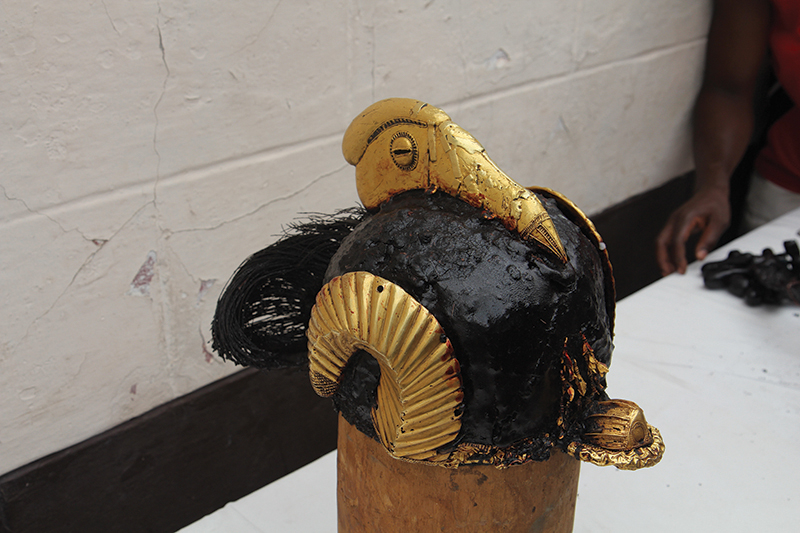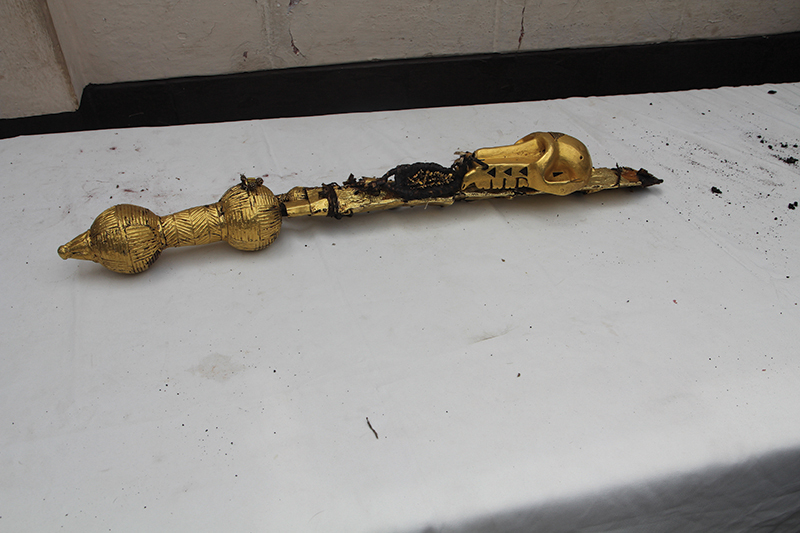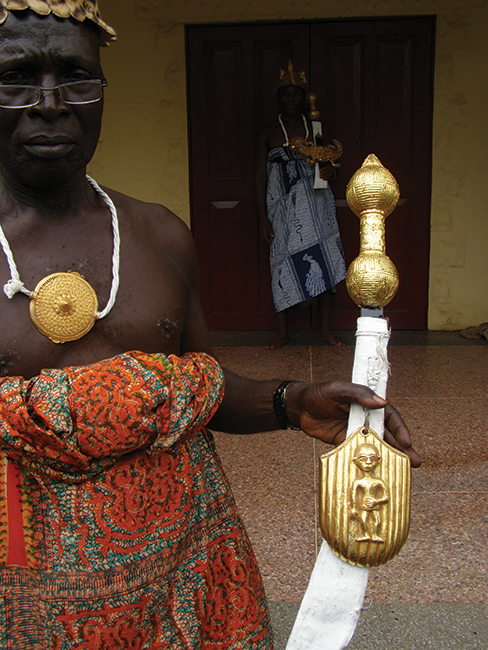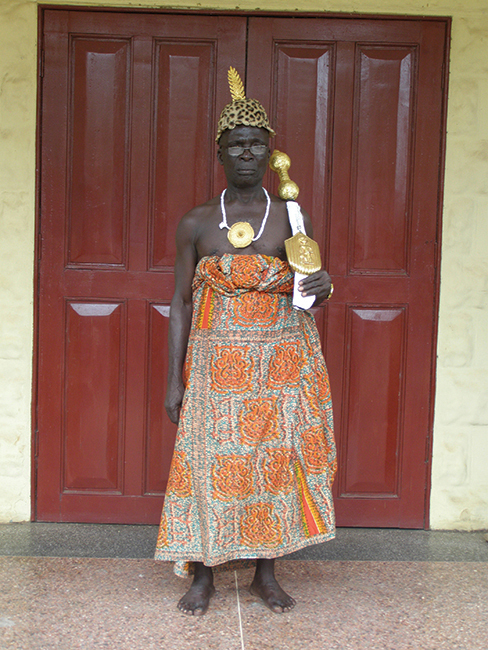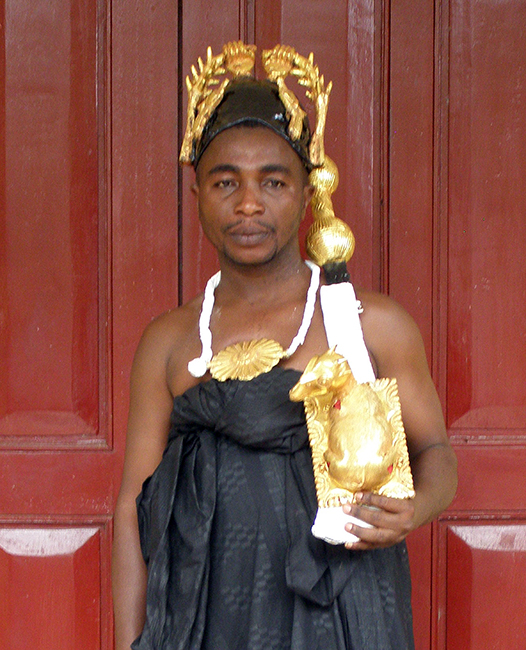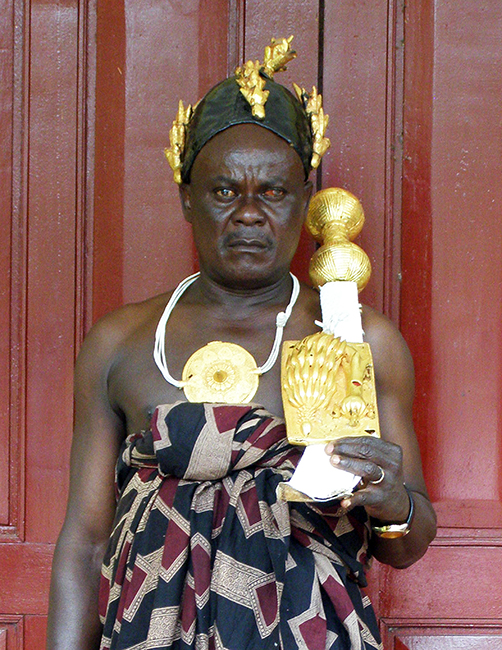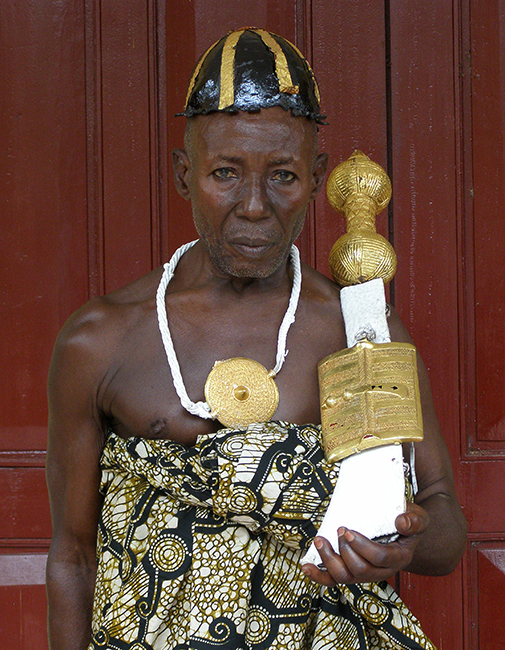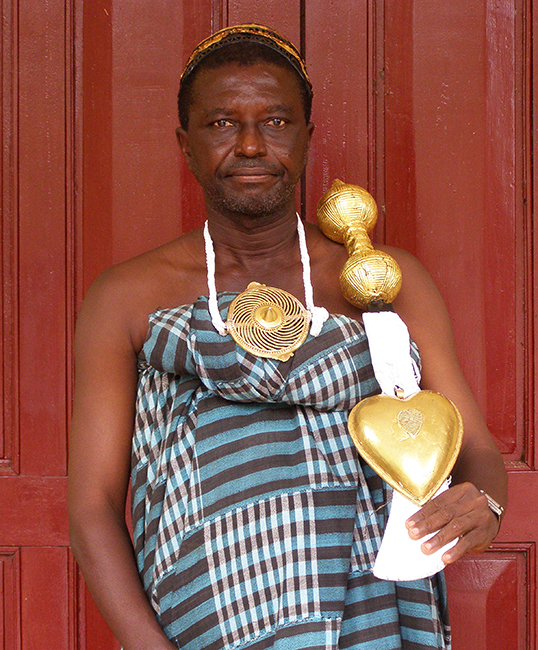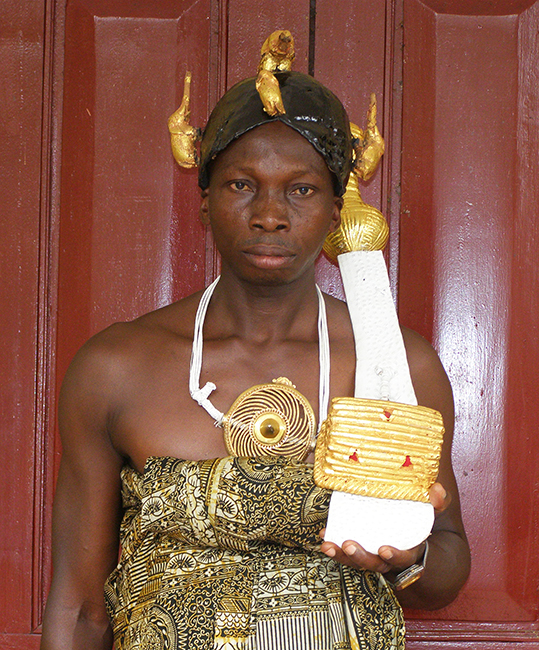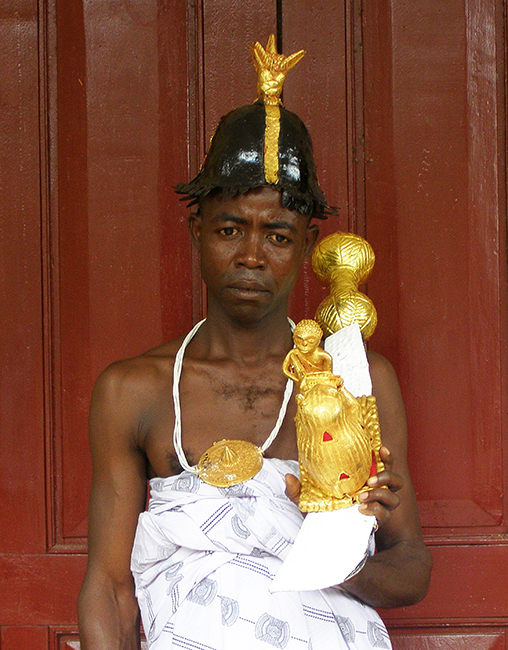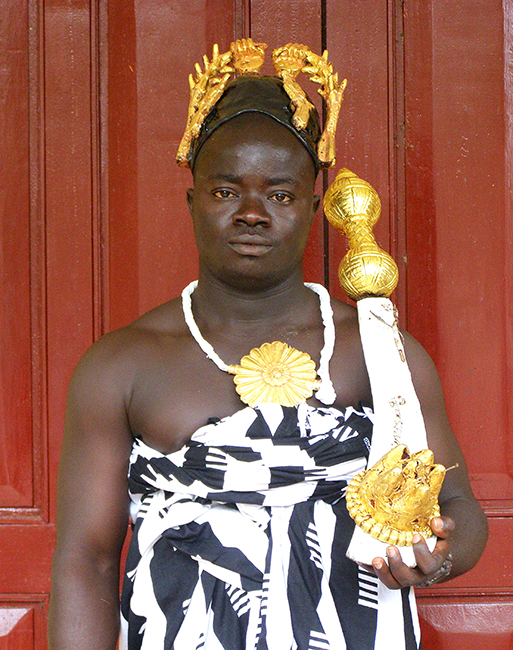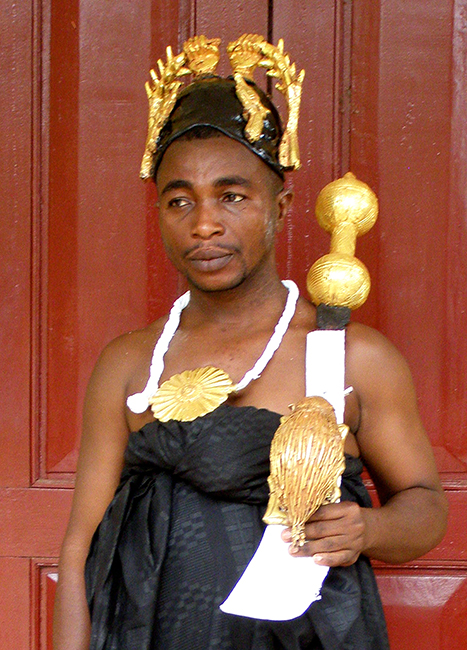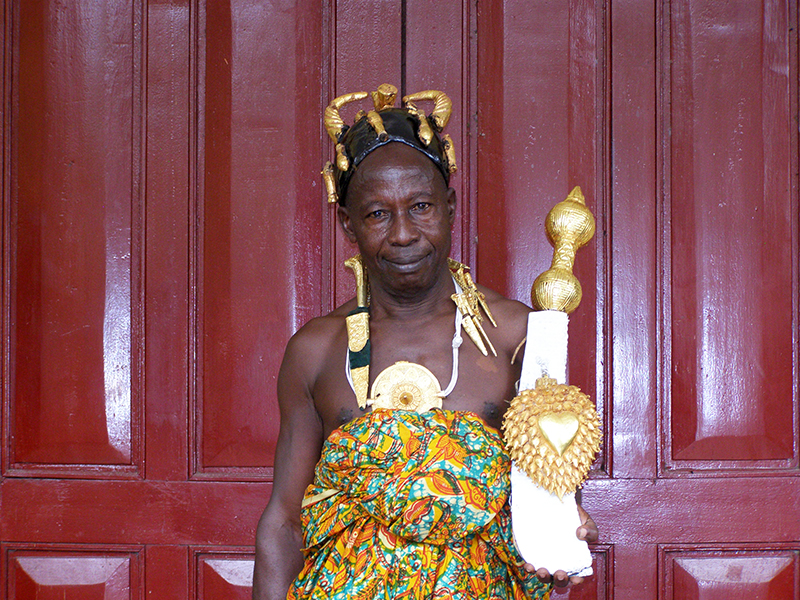
Engaging Modernity: Asante in the Twenty-First Century
Skip other details (including permanent urls, DOI, citation information): This work is licensed under a Creative Commons Attribution-NonCommercial-NoDerivatives 3.0 License. Please contact [email protected] to use this work in a way not covered by the license.
For more information, read Michigan Publishing's access and usage policy.
Afenasoafoɔ (Sword Bearers)
Afenasoafoɔ are the custodians and bearers of swords that are generally referred to as kɛtɛanomfena (lit. swords on the edge of bed) for they are placed at the edge of the king’s bed when he goes to sleep. Additionally, they are placed on the edges of the apakan (palanquin) when the king rides in it as part of a procession. Kɛtɛanofena are further subdivided into two sets: akrafena (swords of the soul) and abosomfena (deity swords). The akrafena are positioned to the right and the abosomfena to the left of the Asantehene during processions and they maintain the same position when he sits in state. In a hierarchical order, the akrafena are: mpɔnpɔnsɔn, ahwebaa, kraku panin, Kra Kofi (Apemase Nsa Da), Kra Kwasi, Kra Kwame, Kraku Kumaa, kɔtɔkɔ, abubummabaa, sakatempobi. Similarly, the abosomfena are: bosomuru, dɛnkyɛm, bosomprapanin, nimsaakakyi, bosompra kumaa (akokɔbaatan), bosomurutwe, esie, esrɛmusei gyata, gyapetia. kɛtɛanomfena are identified by the abɔsodeɛ (cast gold ornaments) of an animal or a fruit representing a proverb or an epigram. Practically, all the kɛtɛanomfena are proverbs conveying a message or statement from the king, or embodying an incident in the history of the kingdom. Further, the Afenesoafoɔ wear a hat mostly made from ɔtwe nhoma (duiker leather) or sebɔ nhoma (the leopard’s skin). Akrafokɔnmu (gold disc-shaped chest ornaments) are usually tied to a rope and hang around the neck to the chest. These are also referred to as pectoral discs and they come in different sizes, shapes, and designs.

From Left: Nana Akwasi Gyaw, Nana Yaw Badu, Kwame Boafo, Nana Kwafo Yiadom II, Nana Kwame Appiah, Kofi Kusi Bosompra, Nana Kofi Kusi, Nana Kwame Adusei, OpaninYaw Sarhene, Akwasi Ahenkan, Nana Kyei Baafoɔ
Bosomuru
Nana Akwasi Sarkodie II, Bosomuruhene
Bosomuru is one of the regalia Osei Tutu captured from Onoo Adu Gyamfi who until his defeat ruled over a wide territory from present day Kumase to as far as Mampong and had settled in Jamase. Onoo is a town in the Kwaabre district in Asante. Ɔkɔmfo Anɔkye then consecrated the bosomuru for Asanteman and added it to the regalia. The history of the gyemirekutu kyɛ (the hat) is however different from the sword. It is said that on his way from Akwamu to inherit his uncle Obiri Yeboa, Osei Tutu met a hunter who had killed an elephant and ɔwam (hornbill). He asked the hunter for the skin covering the elephant’s kneebone, and the feathers of the hornbill. Osei Tutu then placed the head of the hornbill on top of the elephant’s skin, and the feathers on both sides of the skin, and added adwera (portulaca oleracea leafs) on his forehead. He finally placed the adam below the adwera and wore the hat to Kumase and eventually added it to the bosomuru when he captured it from Onoo Adu Gyamfi. In that sense, the bosomuru hat is connected with doku agyapɔmaa (the gun with beads around the lever butt (See Atuotumfoɔ/guns). Osei Tutu brought his gun to Kumase after killing the hunter and his wife (Agyapɔmaa), and placed her waist beads around this particular gun. Apart from Otumfoɔ, no one is allowed to swear the oath of office with the bosomuru sword. That explains the saying in Asante: Bosomuru fa wo bem (lit. bosomuru, you’ve won the case in advance of any precedings). As a spiritual leader, the Asantehene cannot be found guilty or no one can argue and win a case against him and as a result, and in advance of any procedings, the elders and chiefs will throw in the towel with the above words. It is only after swearing the Great Oath of Asanteman with the bosomuru sword, as part of the Pampaso rituals, that a newly enstooled king is recognized as Asantehene. The custodian of bosomuru sits to the immediate left of Asantehene whenever the Asantehene sits in state or during state ceremonies. The bosomuru is considered “holy” and, unlike the mpɔnpɔnsɔn, it is cutomarirly not used for war (ɛmpɛ basabasa). Since it is not proper for women to see the bosomuru, the custodian covers it with ɛnwira (white cloth) when women come close to it or during traditional ceremonies when the queen mothers and women take turns to greet Otumfoɔ. Apart from the Asantehene and the custodian, no chief is allowed to touch or hold it. In the likelihood that the custodian needs to relieve himself during ceremonies, he will either rest it by Asantehene’s feet or at the feet of the Akɔbeahene. Nana Kwaku Dua II is the current Bomomuruhene.
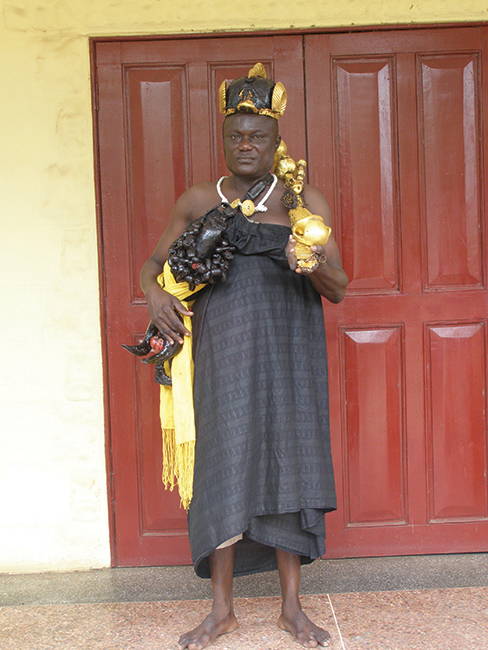
Hat: Gyemirekutu Kyɛ. It is worth noting that Osei Tutu’s original hat had the actual animal parts until they were later replaced with gold cast for durability perhaps from the time of Opoku Ware.
Afodoɔ: As a deity, the afodoɔ is made of the skin of ɛsono abadayɛ (the elephants fetus). It is decorated with six atutugya rings worn on the knees of the king as part of his adornments when he wears the batakarikɛseɛ (the battle dress) during installation rituals. The king wears three rings of atutugya each on his right and left knees. Hanging from the Afodoɔ is a combination of Trɔmoo abɛbɛn (Trɔmoo’s horns) with Adam in the middle, ɛsono bodua (elephant’s tail), and nnaa (a clapper bell). The afodoɔ is worn around the neck to the elbow of the custodian.
Abosodeɛ: The abɔsodeɛ (gold cast) is a replica of the human skull meaning the Asantehene carries all the burden of Asanteman on his head. The saying is: Yɛ de gyemirekutu kyɛ soa wo a, na yɛ de Asanteman asoa wo (lit. you carry the burden of Asanteman when the gyemirekutu hat is placed on your head). A miniature human skull is placed near the hilt as well as sɛpɔ knife considered a miniature of the bosomuru sword also attached closer to the hilt. Unlike the mpɔnpɔnsɔn knife, that of the bosomuru is not used for combat. Two akrafokɔnmu (relatively smaller pectoral discs) hang on a thread around his neck. Around his shoulder and looking like black berries is afodoɔ. Like the hat, it is one of the items Osei Tutu brought to Kumase from Akwamu. Six rings of atutugya are around the afodoɔ and they are divided into two: three on the left side and three on the right side. Before wearing the batakari kɛseɛ during installation rituals, the Asantehene wears three atutugya on his right knee and three on his left knee. The gold sash cloth aesthetically is to provide accent but it was originally the fat of the gaboon viper that is used by Akan herbalists to cure fractures especially, fractured legs. Hanging from the gold sash is the Trɔmo abɛbɛn (trɔmo’s horn) with a red colored adam in the middle. Under the trɔmo abɛn is nnaa (a bell) and elephant tail to the side.
Mpɔnpɔnsɔn (Mponponsuo)
Nana Sefa Ababio, Mpɔnpɔnsɔnhene
The original name of this sword, mpɔnpɔnsɔn, is now known by its corrupted name, mponponsuo (see for instance, A.A.Y. Kyerematen, 1960: 381). The custodian is a chief and he is referred to as Mpɔnpɔnsɔnhene. It is next in rank to the bosomuru. Ɔkɔmfo Anɔkye created the mpɔnpɔnsɔn for Ɔpemsoɔ Osei Tutu’s nephew, Opoku Ware. Soon after Osei Tutu’s sister gave birth to Opoku Ware, the king and the great priest went to visit mother and child. To their amazement, the little boy was waving his hands but these were no ordinary hand gestures. In reaction to this unusual hand gestures, Ɔkɔmfo Anɔkye informed Osei Tutu that, he would create the “mpɔnpɔnsɔn” for Opoku Ware. Not surprisingly, Opoku Ware succeeded his uncle, Ɔpemsoɔ Osei Tutu, and during his reign (circa 1720-1759), he expanded Asante. Practically, all the mfena belong to Asantehene, but the mpɔnpɔnsɔn is considered his personal afena. During processions and depending on the situation, he walks with it by holding the hilt while the Mpɔnpɔnsɔnhene holds the remaining part of the sword. A newly enstooled Asantehene swears the oath of allegiance to his people by using the mpɔnpɔnsɔn. Additional contexts that will call for the use of this sword are: When the Asantehene is dancing to fɔntɔmfrom atoprɛtia with mpɔnpɔnsɔn and a gun. Further, in times of crisis, when the king is performing funerary rites for a deceased member of the royal family, or Ɔmanhene (a paramount chief), or a high-ranking chief at Manhyia Palace. Amanhene (paramount chiefs) and abrempɔn (Kumase chiefs who are recognized as such) use mpɔnpɔnsɔn to swear the oath of office before the Asantehene. It should be noted however that not all Kumase abrempɔn use this sword to swear the oath of office. Whenever the king sits in state for ceremonies, the custodian sits to his immediate right and runs errands. For instance, the Mpɔpɔnsɔnhene may invite visiting dignitaries to greet the king or he may inform assembled chiefs that the king is about to recess. When the Dwabenhene is visiting Kumase, it is the Mpɔpɔnsɔnhene who as it were, goes to the Dwabenhene’s house with the sword to inform him that the Asantehene is sitting in state and it is time for him attend the gathering.

The Hat: Ntakerakyɛ (feathered hat) consists of kɔdeɛ ntakra (eagle’s feathers) tied on a leather helmet with sika and dwetɛ nsɛbɛ (gold and silver talismans) in trianglular and rectangular shapes and a leather extension. The leather with talismans lies in the middle and goes all the way to the back. The front has gold cast of trɔmo abɛbɛn (rams horn) with afɛma in the middle of the two horns. Two akyem prɛbuo (akyem bird’s nests) spherical shapes are positioned to the right and left edges of the leather hat. Like the bosomuru hat, adam is placed below the horns. The back of hat shows several rectangular goldleaf nsɛbɛ sewn on the leather hat.
Green head cover: In order to ensure that the leather hat sits tightly on the head, the head is covered with this green material. It also prevents cuts on the head from the inside of the leather. The green head cover has a star and a gold talisman on the side. Once worn, the hat is kept in place by sika ayaneɛ, a gold chain that is tied from the area around the right ear to the left ear. The akrafokɔnmu is a relatively larger pectoral disc with a pointed mound gold cast in the middle. Additional items worn around the neck is a wooden collection of nnawuro (sin. dawuro) iron idiophone but carved from a wood and covered with goldleaf and the apurukusu (electric fish) without the head. There are six smaller nnawuro and one bigger dawuro. The electric fishes number five and are of the same size. The last item worn around the chest and around the abdomen is the remaining body of amanseɛ pramire (gaboon viper) with trɔmo abɛbɛn (two ram’s horn), with adam in the middle with the gold sash tied over it. Like the bosomuru, the gold sash is to add accent to the regalia and as I have indicated previously, it was originally the fat of the gaboon viper. The mpɔnpɔnsɔn sword is encased in etwie nnwoma or bɔha (a leopard’s skin sheath). Close to the hilt is the sɛpɔ type of knife known as kumabrempɔn (killer of chiefs). Unlike the bosomuru, Asante kings took the mpɔnpɔnsɔn to war and this knife was used in decapitating heads of enemy chiefs. That is why the Asantehene uses the mpɔnpɔnsɔn to demostrate heroic ideals and his readiness to defend Asanteman when he is dancing fɔntɔmfrom atoprɛtia in combination with the apankantuo (see Atuotumfoɔ/Guns). Abɔsodeɛ is amanseɛ pramire (gaboon viper) that has captured ɔwam (the hornbill). The mystery of how a snake could capture a hornbill that flies above is a proverb about patience or as the Akan will say, me de asaase anya wam (lit. the earth has given me a hornbill). In other words, when for some unexplained reason, the hornbill crashed on earth, the viper who was laying patiently on the ground took advantage of the fall and immediately captured the hornbill. A leopard’s leather with sika ne dwete nsɛbɛ (gold and silver talismans) is attached to the sheath near the viper snake and extends down to the ground.
Ahwebaa
Nana Kyei Baafoɔ
Although they were still under Denkyira, the various chiefs in and around Kumase were independent and ruling their territories when Ɔpemsoɔ Osei Tutu arrived in Kumase from Akwamu. In order to form a larger state that could defeat Denkyira, Osei Tutu, with the help of his spiritual advisor, Kɔmfo Anɔkye, was able to bring in some of these states peacefully through diplomatic means or forcefully by conquest. In those days, Osei Tutu fought and conquered states including Amakom, Tafo, Boɔkurom, and Ohwim. Once they established the Amantoɔnum (the Five States) that formed the core of Asante Empire, Osei Tutu slapped his belly with his hand saying, “Asanteman gye meɛ” (Save me/help me Asanteman). Kɔmfo Anɔkye immediately created the ahwebaa sword with the abɔsodeɛ capturing the incident with a man holding his belly with his left hand and asked Nananom Amanhene including the Mampɔnhene and Dwabenhene to swear the oath of allegiance with ahwebaa. Historically, ahwebaa came before mpɔnpɔnsɔn and several of the swords. Since mpɔnpɔnsɔn is Asantehene’s personal sword, most people wrongly assume that those who swear the great oath with it are more important and powerful than those who swear with ahwebaa. But that is not the case for a chief may use the mpɔnpɔnsɔn to swear but he may not come close, in terms of rank and power, to a chief who, due to history and customs, uses the ahwebaa to swear the great oath of Asanteman. Nkɔnsɔnhene, Hyiawuhene, and Anonomsahene (to name a few) are some of the chiefs who swear the oath of office with ahwebaa.
Dɛnkyɛm (Crocodile)
Nana Kwame Adusei
Asantehene Osei Kwadwo (Ɔko Awia-He fights in broad daylight; 1764-1777) created the dɛnkyɛm (crocodile sword) for the custodian to assist bosomuru to efficiently perform its duty, In the absence of the custodian of bosomuru, the bearer of dɛnkyɛm sword is elevated to his spot and performs all the duties ascribed to bosomuru. Ntotoyɛhene and Nsutahene are two chiefs who have links with this sword. Prior to being elevated to the position of Nsutahene by Otumfoɔ, the former was responsible for the abusuapoma (family staff) and that can be translated into the chief spokesperson. Then the royal spokesperson’s staff was given to the Ntotoyɛhene who was then the Dɛnkyɛmenasohene. To this day, the ntuakyire on top of Ntotoyɛhene’s umbrella is the crocodile. The staff finally was transferred to the chief of Jachie popularly known as Jachie Amoateng where it has remained since and that is why the chief of Jachie is one of the senior royal spokesperson’s of the Asantehene. Additionally, the dɛnkyɛm sword either leads or is part of a delegation whenever a message is sent to the present Nsutahene (also considered the uncle of the Asantehene).

The Hat: Leather hat with Akobɛn (ivory trumpet) on top with Ɛsrɛm Sei (lions) on ɔtwe nwoma akrafokɔnmu
Abɔsodeɛ: Dɛnkyɛm. like the crocodile that protects its eggs, the Asantehene will fearlessly protect Asanteman. It is said that no matter how far a crocodile may be away from its eggs, all it takes is a second for it to return and attack a potential intruder.
Bosompra Panin
Nana Kofi Kusi, Bosompra Paninhene
Asantehene Kwaku Dua (1824-1834) created bosompra panin sword primarily for the royal family and since the Asantehemaa (the Asante queen) is head of the royal family, it represents her during purification rituals for the royal family. The bosompra sword is restricted to communications between the king and the Asantehemaa’s household and do not, as custom demands, go to any chief’s house. During gatherings (festivals, durbars, funerary rites or any state function), it is customary for the Asantehene’s precession to be in place with the king well sitted before the bosompra Paninhene is sent to the queen mother to inform her that the king is ready for her mother (biological or symbolical) to join him. For the queen mother, the presence of bosompra panin in her court is an indication that the king and elders are waiting for her since she will never join the ceremony without this special invitation with the bosompra panin sword. After greeting her son, the queen then takes her rightful place to the left of the king. The queen mother will never join the king in any ceremony or gathering unless bosompra panin sword is sent for her. This sword used to be known as bosompra until Asantehene Agyemang Prempeh (1888-1931) created another one in the same category and in order to distinguish the first from the second sword, they added the designation “panin” (older) to it (see Bosompra Kuma below). In deep Twi, bosompra refers to a benefactor who is highly dependable for providing sustenance. In other words, bosompra is a metaphor and an indication that the king is responsible for providing for the spiritual and material needs of the royal family and the larger community in all kinds of ways. Bosompra panin sits to the left of Asantehene. Kra adwareɛ refers to soul purification rites for a sitting king. This ritual is performed once a week on the day the king was born. Before a newly enstooled king creates his swords with abɔsodeɛ, bosompra panin is used to represent him during purification rites for his soul until he creates his own sword or swords.
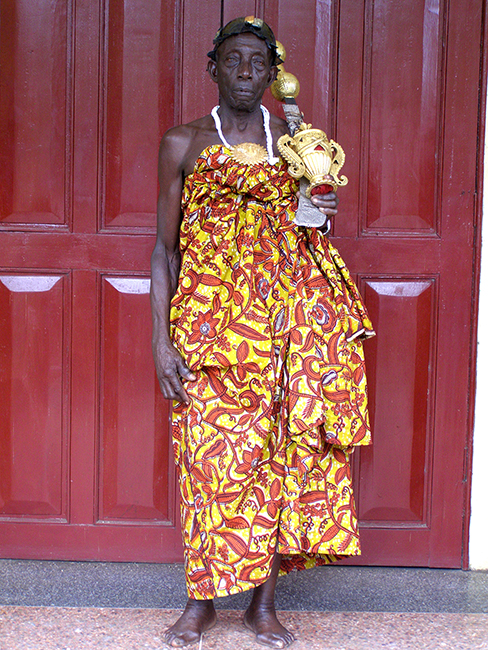
The Hat: Consists of dwetɛ and sika kɔkɔɔ nsɛbɛ (silver and gold plated talismans) are attached to the leather. The abɔsodeɛ is the kuduo (silver treasury casket), with adweraa placed on top. Adweraa is found in rivers and that is the leaf they dip in water during the purification of the soul rites and sprinkle on those present.
Bosompra Kumaa
Kwafo Yiadɔm
Otumfoɔ Agyeman Prempeh (1888-1931) created bosompra kuma sword upon his return from exile in Seychelles in 1924. In order to save Asanteman from total annihilation by the British forces 1896, he gave himself up and the British took the queen mother, Nana Yaa Akyaa, some of his chiefs, and elders to far away Seychelles in the Indian Ocean. With a hen and her chicken as abɔsodeɛ, Nana Agyemang Prempeh is indicating that as the Asantehene, he is protective of his children just as the hen protects her chicks. He gave this sword to his abusua (the royal family) and since bosompra panin was already assigned to his abusua, they named this sword “kuma,” (the younger). Strictly speaking, and unlike bosompra panin, this sword is not used in purification rites for the soul. In rare cases, it replaces bosompra panin when the custodian is not available. However the Asantehene can send the custodian on several errands related to the royal family.
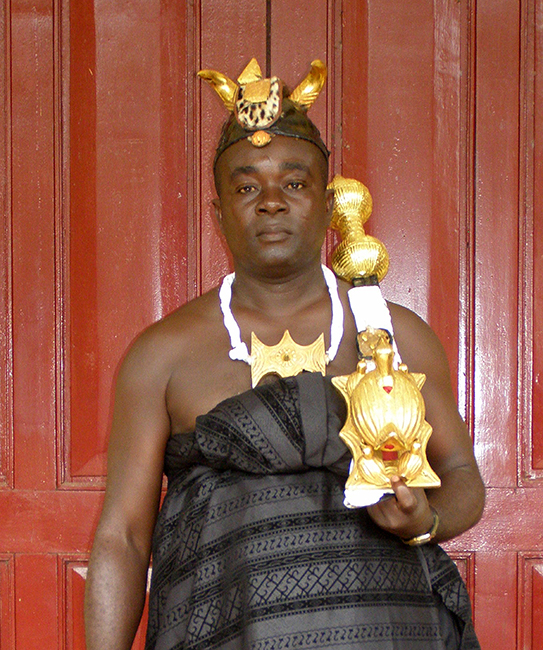
The Hat: A gold plated adam (cowrie shell) is attached to the hat and extends to the forehead. Two akobɛn (ram’s horn) are attached to each side, nsɛbɛ (talisman) covered with a leopard skin with a rectangular and a triangular sika kɔkɔɔ nsɛbɛ (gold plated talismans) on top. His akrafokɔnmu is different from most of the sword bearers. Two archs face upwards and downwards.
Bosomurutwe
Kwame Boafo
On January 31, 1935, Asantehene Agyeman Prempeh II (Kwame Kyeretwie) finally succeeded in restoring Asanteman (or Asante Confederacy) and in commemoration of this historical feat, created Bosomurutwe (Maxwell Duiker). In doing so, he declared: Ɔtwe, me twe me man. Me man na me twe. That is, Ɔtwe, I am pulling (twe in Twi) my nation [back] together. In this particular instance, the phonology of the word twe (pull) in Twi is the determining factor in choosing the abosodeɛ. The action of pulling is evident on top of the accompanying hat with the two hands pulling two palm trees and bringing them together. The action of pulling is also indicative of how daunting it was to bring former states of the union together considering that most of them were enjoying their newlyfound independence after severing their ties with the Asante Kingdom. It should be recalled that Asanthene Agyemang Prempeh initiated the restoration of Asanteman when the British eventually returned him from Seychelles in 1924. One of the conditions for his return was for him to limit his reign to being Kumasehene (not Asantehene). Although Asanteman agreed to that stipulation, what the British did not understand is that Kumasehene is technically the Asantehene. At any rate, Nana Agyeman Prempeh worked tirelessly and was determined to restore the kingdom but he passed away in 1931 before he could accomplish his goal. On assumption of office in 1931, Agyemang Prempeh II embarked on this difficult task and eventually succeeded in restoring the Asante Confederacy in 1935.
Kra Kofi (Apemase Nhye Da)
Kwame Agyemang
Nana Agyemang Prempeh II (Kwame Kyeretwie) created kra kofi in remembrance of his great uncle, Nana Agyeman Kofi, who is known in the annals of Asante history as, Adaduananhene (Forty-days king). He died of mpɛtɛ (Chicken pox) exactly on the fortieth day of his enstoolment. Nana Agyemang Kofi’s reign preceded Nana Kwaku Dua II alias Nana Agyemang Prempeh in 1888. Otumfoɔ Agyeman Prempeh II wanted the name and memory of his great uncle enshrined in posterity so he created two swords, the above-named sword and nim saa aka akyi. The proverb for the latter is his expression and understanding that his great uncle did not have the opportunity to execute his vision for Asanteman due to the untimely intervention of death. For the abɔsodeɛ of the former, he chose the Akan saying; Apem ase nhye da as evidence of the continuing growth and bearing of fruit of the plantain tree. For the small pox might have killed his great uncle, it could not eradicate the royal family and like the plantain tree will never be without smaller shoots. His lineage (the royal family) will endure despite life’s manifold challenges that we, as humans, face (Ross, 2009: 115).
Kraku Panin
Nana Kwame Owusu
As I have noted previously, prior to the introduction of guns, the sword and shield were the main weapons and as a result, they represent valor and heroic ideals. Kraku panin was made for Asantehene Kwaku Dua (1834-1867), well known in the annals of Asante history as an exceptional man of peace.
Kraku Kumaa
Nana Akwasi Gyaw, Kraku Kumaahene
In 1977, Otumfoɔ Opoku Ware II created two swords, kraku kumaa and funtunfunefu dɛnkyɛm funefu. For the former, the abɔsodeɛ is akoma (the heart) and the latter the Siamese crocodile, a well-known adinkra symbol, as abɔsodeɛ. During his reign, the political climate in Ghana was quite challenging for Opoku Ware II and Asanteman as the nation witnessed unprecedented military takeovers from early 1970s to 1981. In his response to various sections of Asanteman for their king to take action or to step in and stop military takeovers, he responded by saying, mede makoma ato nsuom (I have placed my heart in water). Literally, he is cooling his heart and will not allow his temper to rise. Otumfoɔ Opoku Ware’s choice of the Siamese crocodile was in reference to his own uncle who, despite loosing his bid to ascend the Gold Stool, was until his [uncle’s] death not happy with the selection of Opoku Ware II as Asantehene. So the king said, yɛ nyinaa ya furu baako nanso tɛkrɛma so dɛ nti, na me Wɔfa ɔne me prere akonwa, yɛ de ama me nti no, ɔse ɔnte ne ho ase.” Literally, he and his uncle belonged to the same family (abusua) and any benefit will pass through the same stomach but due to ‘sweetness of the tongue,’ his uncle never forgave the kingmakers for selecting him. Metaphorically, the single stomach of the Siamese crocodile represents the single destiny of the royal family.
Abubummabaa
Nana Kwame Appiah
Since ascending Sikadwa Kofi in 2009, Otumfoɔ Osei Tutu II has added four kɛtɛanomfena to the regalia. They are abubummabaa, sakatempobi, esie, and ɛsrɛm sei gyata. Sakatempobi and ɛsrɛm mu sei gyata have corresponding guns that Otumfoɔ created for the same purpose. The mystery of how the abubummabaa created its dwelling has never been resolved and as a frame of reference, Osei Tutu II stated that he is the one who established a union of states that resulted in the formation of Asanteman. This is what he said: “I am Osei Tutu. It was I who founded Asanteman. I have returned and that is why I am like the abubummabaa. Ɛkwan ko a me faa so yɛyɛ, sɛ me kɔ mu, sɛ mankɔ mu, sɛ me wene yɛ, me ara na masan aba. Ɛna me bɛbu ma Asanteman. He has returned to continue his work and like the abubummabaa, we have no idea how he entered his enclave/house. Whether he weaved his abode first before he entered or whether he weaved his house around him, he has come back.” Based on his actions since his enstoolment, the Asante generally agree and refer to him as Osei Tutu Ababio (that is, Osei Tutu has come again or returned).
Sakatempobi
Nana Yaw Badu
Sakatempobi are nkranee (big ants in the forest) that in times of bush fires, while the undergrowth is burning, they continue to feed on grasshoppers as they leave the scene of the fire. The proverb in Twi stipulates, egya ɛhye sakatempobi no, na ɔsɔ mmɛbɛ (grasshoppers). In creating this sword, Otumfoɔ Osei Tutu II said, “ɔno wasan aba no, nea ɔbɛka sɛ ɔbɛyɛ biara no, ɔbɛ yɛ. Ɛnyɛ nea obi bɛka na ɛbɛ ma no agyae neɛ ɔpɛsɛ ɔyɛ.” He will come back to continue his work and no matter what people might do or say, he will accomplish whatever tasks he has set up for his return.
Esie
Nana Kwasi Yeboah
Nana Poku Ware II created esie. Since his day name was Kwaku which happens to be the same for Otumfoɔ Osei Tutu II, esie is central in the soul purification rituals for the present king on Wednesdays. The abɔsodeɛ is esie (a mound) and as the Akan proverb goes, esie nanimuonyam ne mmire (lit. the value of a mound is based on the quality of mushrooms it produces/that grow on it). Therefore Asanteman’s value is Otumfoɔ for compared to all the ten regions in Ghana, Asante is the only region with a single king. Consequently, esie refers to Asanteman while emire (mushrooms) refers to Otumfoɔ Osei Tutu II.
Ɛsrɛm Sei Gyata
Nana Kofi Brefo
Created by Otumfoɔ Osei Tutu II with a corresponding gun. As a predator the fierce attributes of the lion is well documented. Unlike the leopard that lives in dense forest regions and is capable of climbing trees, the lion, on the contrary, lives in savannah grassland areas. The appellation ɛsrɛm sei gyata literary means osei from the savanna grasslands that is brave and fierce like the lion. No one (including his enemies) can overrun the Asantehene just as no animal is capable of doing the same to the lion.

The Hat: Decorated with circular strips of gold leaf. The akrafokommu is a gold cast of two arcs joined together with a tadeɛ (a lake in the middle). The abɔsodeɛ, a lion is a gold cast of a lion.
The custodian, Nana Kofi Brefo, was not available for the picture. Nana Kwafo Yiadom II stood in for him.
Kɔtɔkɔ
Kwame Boafo
This is a special sword made by the Asante Kɔtɔkɔ Society in Kumase to honor Nana Opoku Ware II on his enstoolment as the 15th occupant of the Gold Stool. In honoring the King, the Society remarked that Opoku Ware was the first Asante king with the highest academic credentials. Opoku Ware II (known in private life as Kwaku Adusei Poku), studied law in the United Kingdom and was called to the Bar at Middle Temple in 1962. In 1970 he was appointed Ghana’s Ambassador designate to Italy but he could not fulfill his duty since he was enstooled the same year when his uncle, Otumfoɔ Osei Agyemang Prempeh II, died. Since the days of warfare are over and in order to encourage Opoku Ware II to use the power of the “pen” to accomplish a great deal for Asanteman and Ghana, the Society used the gun and pen as abɔsodeɛ.
Gyapetia
Nana Kofi Brefo
Although gyapetia is one of the oldest kɛtɛanomfena, the custodian does not possess a hat, akrafokonmu and abɔsodeɛ. Gyapetia is the main sword that Asante Adikrofoɔ (head of towns) use when swearing the great oath ahead of their chief who is unturn going to swear the great oath to the Asantehene. Kɔmfo Anɔkye also made a pronouncement that since the Amanhene were using the ahwebaa to swear the great oath, their elders who preceded them should use the gyapetia sword. Swearing the oath with gyapetia spiritually ensures loyalty and compliance on the part of the elders making the agreement with Asanteman binding. In order to insure a tight alliance, he made conquered chiefs and those who willingly joined Kumase to swear the oath of allegiance with the gyapetia sword that Kɔmfo Anokye created. According to Kɔmfo Anɔkye, no matter how powerful a chief might be, they are entirely subdued once they swear with gyapetia. When the Asantehene Osei Bonsu brought items from the ocean to Kumase on his return from the Asante-Fante war, he introduced the ɛtwom (apurukusu/electric fish) skin for the scabbard for this sword.
Krakwame (Bɛmuu)
Akwasi Ahenkan
Asantehene Agyemang Prempeh II created this sword with the abɔsodeɛ made of a bunch of palm kernels with a heart resting on them. There are two interpretations. The first describes what happens when the bunch of palm kernels is harvested and it falls on the ground, it collects all fallen leaves. The second is that, palm kernels grow on a common stock and in that sense, those of a common stock share the same origin so the king was going to put his heart into uniting the kingdom.



